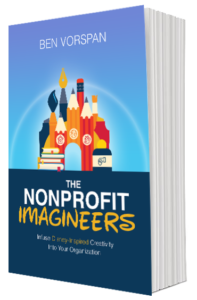
Disney Imagineering is renowned for its innovative approach to designing immersive and memorable experiences. They employ a methodology known as design thinking, which places the audience’s needs and experiences at the core of the creative process. While we don’t use “Design Thinking” as a term in The Nonprofit Imagineers book, we do cover the underlying concepts as they are central to creating impactful, imaginative events. Nonprofit organizations can greatly benefit from adopting this perspective when planning major events, such as galas and fundraisers. In this article, we will explore how design thinking, as inspired by Disney Imagineering, can lead to more creative and audience-focused nonprofit events.
Understanding Design Thinking
Design thinking is a human-centered, problem-solving approach that prioritizes empathy, creativity, and iterative development. It consists of several stages, often summarized as follows:
- Empathize: Understand the needs and desires of your audience deeply.
- Define: Clearly define the problem you are trying to solve or the experience you aim to create.
- Ideate: Brainstorm creative solutions and concepts.
- Prototype: Create low-cost, low-risk prototypes of your ideas.
- Test: Gather feedback and iterate on your prototypes.
Disney Imagineers employ this methodology to design theme park attractions and experiences that captivate and delight visitors. Nonprofits can adapt this approach to ensure their events are equally captivating and effective.
Stage 1: Empathize
Begin your event planning process by deeply understanding your audience. Just as Disney Imagineers aim to understand the needs and expectations of park visitors, nonprofits must understand the motivations and desires of their event attendees. Conduct surveys, interviews, and focus groups to gather insights.
Stage 2: Define
Clearly define the purpose of your event and the specific goals you want to achieve. Whether it’s raising funds, increasing awareness, or fostering community engagement, having a well-defined goal is crucial. Disney Imagineers define the essence of each attraction, ensuring it aligns with the overall theme and park experience. For more about this, check out the section on Creative Intent in chapter 1.
Stage 3: Ideate
This is where creativity flourishes. Encourage your event planning team to brainstorm creative ideas that align with your defined purpose and audience insights. Disney Imagineers engage in “blue sky” brainstorming sessions to generate innovative concepts for their attractions. Similarly, your team should explore unique event concepts, activities, and themes. Blue Sky details are found in chapter 4, and there’s a brainstorming guide in our Imagineers Resources section.
Stage 4: Prototype
Create low-cost, low-risk prototypes of your event elements. This could include designing mock event layouts, crafting sample decorations, or developing a mini-version of an interactive exhibit. Just as Disney Imagineers build prototypes of their rides and attractions to test their feasibility and appeal, nonprofits can assess the practicality and appeal of their event concepts.
Stage 5: Test
Gather feedback and iterate on your event prototypes. Engage a select group of individuals who represent your target audience to provide valuable insights. Disney Imagineers conduct extensive testing of their attractions with small groups before opening them to the public. Nonprofits should similarly refine their event elements based on real-world feedback. By starting simple, and iterating toward your final goal, you will also cut down on the risk of creating something that might fail. Check out chapter 2 for more about preventing failure.
Applying Design Thinking to Nonprofit Events
By integrating design thinking principles into nonprofit event planning, organizations can achieve several benefits:
Audience-Centric Approach: Design thinking ensures that your event is tailored to your audience’s preferences and needs, enhancing their overall experience.
Innovation: Creative brainstorming and prototyping lead to fresh event concepts and activities that can set your nonprofit apart and attract attendees.
Efficiency: Identifying and addressing potential issues during the testing phase can prevent costly mistakes and logistical challenges during the actual event.
Effectiveness: A well-defined purpose and goal-driven approach increase the chances of achieving the desired outcomes, whether it’s raising funds, creating awareness, or fostering community connections.
Adopting a design thinking perspective inspired by Disney Imagineering can be a game-changer for nonprofit organizations planning major events. By empathizing with the audience, defining clear goals, ideating creatively, prototyping smartly, and testing effectively, nonprofits can create events that are not only memorable but also drive meaningful impact and support for their causes. So, let the magic of design thinking guide your next nonprofit event, and watch the results exceed your expectations.
Enjoy thinking creatively? You’ll want to read The Nonprofit Imagineers and join our group of creative nonprofit employees and supporters.
 Celebrate 2 years of Imagineering!
Celebrate 2 years of Imagineering!
Comments are closed